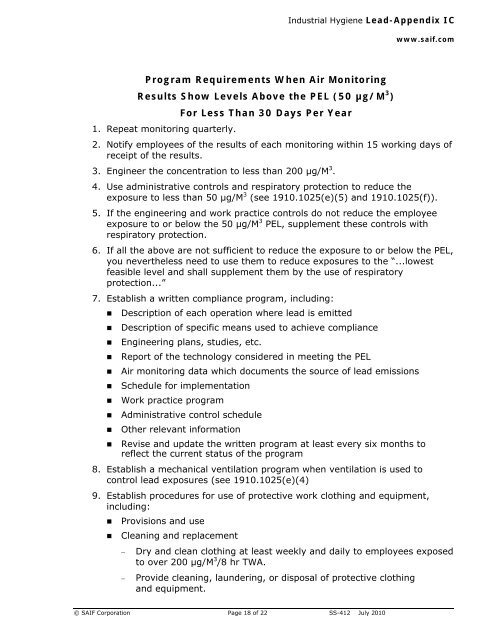Lead - SAIF Corporation
Lead - SAIF Corporation Lead - SAIF Corporation
Industrial Hygiene Lead-Appendix ICwww.saif.comProgram Requirements When Air MonitoringResults Show Levels Above the PEL (50 µg/M 3 )For Less Than 30 Days Per Year1. Repeat monitoring quarterly.2. Notify employees of the results of each monitoring within 15 working days ofreceipt of the results.3. Engineer the concentration to less than 200 µg/M 3 .4. Use administrative controls and respiratory protection to reduce theexposure to less than 50 µg/M 3 (see 1910.1025(e)(5) and 1910.1025(f)).5. If the engineering and work practice controls do not reduce the employeeexposure to or below the 50 µg/M 3 PEL, supplement these controls withrespiratory protection.6. If all the above are not sufficient to reduce the exposure to or below the PEL,you nevertheless need to use them to reduce exposures to the “...lowestfeasible level and shall supplement them by the use of respiratoryprotection...”7. Establish a written compliance program, including:• Description of each operation where lead is emitted• Description of specific means used to achieve compliance• Engineering plans, studies, etc.• Report of the technology considered in meeting the PEL• Air monitoring data which documents the source of lead emissions• Schedule for implementation• Work practice program• Administrative control schedule• Other relevant information• Revise and update the written program at least every six months toreflect the current status of the program8. Establish a mechanical ventilation program when ventilation is used tocontrol lead exposures (see 1910.1025(e)(4)9. Establish procedures for use of protective work clothing and equipment,including:• Provisions and use• Cleaning and replacementDry and clean clothing at least weekly and daily to employees exposedto over 200 µg/M 3 /8 hr TWA.Provide cleaning, laundering, or disposal of protective clothingand equipment.© SAIF Corporation Page 18 of 22 SS-412 July 2010
Industrial Hygiene Lead-Appendix ICwww.saif.comRepair or replace required protective clothing and equipment asneeded to maintain their effectiveness.Ensure that all protective clothing is removed at the completion of awork shift only in change rooms provided for that purpose.Assure that contaminated protective clothing which is to be cleaned,laundered, or disposed of is placed in a closed container in the changeroom which prevents dispersion of lead outside the container.Inform in writing any person who cleans or launders protectiveclothing or equipment of the potentially harmful effects of exposureto lead.Ensure that containers of contaminated protective clothing andequipment are labeled as below:CAUTION: CLOTHING CONTAMINATED WITH LEAD. DO NOT REMOVEDUST BY BLOWING OR SHAKING. DISPOSE OF LEAD CONTAMINATEDWASH WATER IN ACCORDANCE WITH APPLICABLE LOCAL, STATE ORFEDERAL REGULATIONS.Prohibit the removal of lead from protective clothing or equipment byblowing, shaking or any other means which disperses lead into the air.10. Establish housekeeping procedures which deal with sweeping and vacuumingthe floors (see 1910.1025(h)).11. Establish hygiene facilities and practices (see 1910.1025(i)), including:• Change rooms• Showers• Lunchrooms• Lavatories12. Annual training, using the Appendix A and B of the OR-OSHA lead standard.© SAIF Corporation Page 19 of 22 SS-412 July 2010
- Page 1: INDUSTRIAL HYGIENELeadTopicPageAn O
- Page 6 and 7: Industrial Hygiene Lead-General Ind
- Page 10 and 11: Industrial Hygiene Lead-General Ind
- Page 12 and 13: Industrial Hygiene Lead-General Ind
- Page 14 and 15: Industrial Hygiene Lead-General Ind
- Page 16 and 17: Industrial Hygiene Lead-Appendix IA
- Page 20 and 21: Industrial Hygiene Lead-Appendix ID
- Page 22: Industrial Hygiene Lead-Appendix ID
Industrial Hygiene <strong>Lead</strong>-Appendix ICwww.saif.comProgram Requirements When Air MonitoringResults Show Levels Above the PEL (50 µg/M 3 )For Less Than 30 Days Per Year1. Repeat monitoring quarterly.2. Notify employees of the results of each monitoring within 15 working days ofreceipt of the results.3. Engineer the concentration to less than 200 µg/M 3 .4. Use administrative controls and respiratory protection to reduce theexposure to less than 50 µg/M 3 (see 1910.1025(e)(5) and 1910.1025(f)).5. If the engineering and work practice controls do not reduce the employeeexposure to or below the 50 µg/M 3 PEL, supplement these controls withrespiratory protection.6. If all the above are not sufficient to reduce the exposure to or below the PEL,you nevertheless need to use them to reduce exposures to the “...lowestfeasible level and shall supplement them by the use of respiratoryprotection...”7. Establish a written compliance program, including:• Description of each operation where lead is emitted• Description of specific means used to achieve compliance• Engineering plans, studies, etc.• Report of the technology considered in meeting the PEL• Air monitoring data which documents the source of lead emissions• Schedule for implementation• Work practice program• Administrative control schedule• Other relevant information• Revise and update the written program at least every six months toreflect the current status of the program8. Establish a mechanical ventilation program when ventilation is used tocontrol lead exposures (see 1910.1025(e)(4)9. Establish procedures for use of protective work clothing and equipment,including:• Provisions and use• Cleaning and replacementDry and clean clothing at least weekly and daily to employees exposedto over 200 µg/M 3 /8 hr TWA.Provide cleaning, laundering, or disposal of protective clothingand equipment.© <strong>SAIF</strong> <strong>Corporation</strong> Page 18 of 22 SS-412 July 2010



